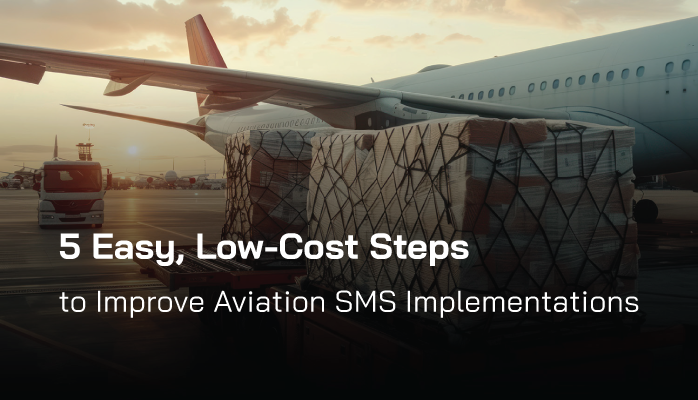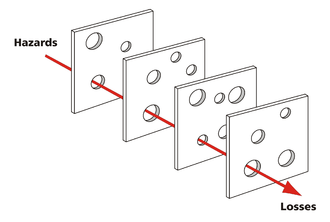What Is Improvement for Your Aviation SMS Implementation?

Improving your aviation safety management system's (SMS) effectiveness doesn’t always have to be a long-term effort. Just as with any complex initiative, there will always be low-hanging fruit in your SMS implementation that can add considerable value without requiring extravagant expenses or investments in time.
SMS implementation and continuous improvement activities require long-term strategies. Nonetheless, there are simple ways you can quickly and easily improve the core aspects of your aviation SMS implementation in a very short amount of time.
Related Aviation SMS Implementation Articles
- Why Should We Implement Aviation SMS?
- Overview of 4 Phases of Aviation SMS Implementation With Free Resources
- How to Create Aviation SMS Implementation Plan - With Templates
Understanding the Scope of Aviation SMS Improvements
When we are talking about “improving your SMS implementation”, we are talking about:
- Better use of safety data;
- A greater understanding of how/why your SMS functions;
- Improved safety behavior;
- Better use of company policy; and
- Enhanced hazard analysis techniques.
Quick increases in safety performance are always the result of simple changes in management behavior, or optimization of existing resources. Here are 7 aviation SMS improvements that you can develop right away.
1 – Include Safety Performance in Regular Employee Performance Review
If you are not already doing so, the best thing that you can get started on right away is to begin including safety performance metrics in employee performance reviews. It’s no secret why so many aviation SMS implementations struggle with employee involvement:
- Safety performance metrics aren’t being tracked for individual employees;
- Employees sense that SMS participation is optional;
- Safety promotion activities are not resonating with employees;
- Safety performance isn’t being reviewed, or being reviewed separately from regular performance reviews; and
- Therefore, there are no incentives to put any sincere effort into participation in the safety program.
Safety performance needs to be an integral part of employees’ assigned duties and responsibilities. Monitoring safety performance in aviation SMS involves tracking metrics like:
- Average number of reported issues per business period (i.e. 6 months or annually) vs company average;
- How many safety meetings were attended out of the total expected meetings;
- Percentage of assigned safety messages employee has read and acknowledged on time;
- How many safety training courses were completed vs total relevant training courses;
- The average score at end-of-course competency testing; and
- On-time safety task completion vs total assigned safety tasks.
There are certainly other metrics to track, but this shortlist will get you started. You simply need to decide which metrics to track and build them into your regular performance reviews.
Related Articles on Employee Performance Monitoring in Aviation SMS
- How Employees Should Be Participating in Your SMS
- 4 Tips to Monitor Employee Safety Performance in Aviation SMS
- 7 Charts to Monitor Employee Safety Performance in SMS
2 – Pick a Handful of Aviation SMS Program Leading Indicators
Leading indicators in aviation SMS can be extremely intimidating for safety managers without formal risk management training. They are among the best tools available to practice proactive risk management and are used to identify precursors to risk.

The majority of aviation safety managers don’t purposely or actively track leading indicators because these safety managers:
- Don't understand the benefits of leading indicators;
- Believe their company is too small to benefit from analyzing leading indicators;
- Are intimidated by unfamiliar risk management terms;
- They don’t have SMS data management tools to easily monitor complex data interactions required with leading indicators; or
- They don’t quite understand what leading indicators are and what leading indicator metrics look like.
If any of the bullet points above sound familiar, don’t worry. You don’t need a huge repository of leading indicators for them to be useful. Start small. Choose a few metrics from our list of aviation SMS leading indicators that apply to your company and are within your aviation SMS data management capabilities to easily monitor.
Choosing just a few metrics in the right area of your aviation SMS such as relating preparedness or teamwork, can immediately help you understand the organizational weakness in either implemented risk controls or your risk management processes. See our list below and choose several metrics now.
3 – Use Data-Based Hazard Identification Training
I staunchly stand by behavior-based training in aviation SMS implementations. Hazard identification training should:
- Align with company safety goals and objectives;
- Be built around employees in your organization (their roles, job positions, education level, language skills, etc.);
- Address their specific behaviors (for better or worse); and
- Apply to current, specific needs addressing operational safety concerns, such as recurring safety incidents.
To address specific needs and trends in employee behavior, you need data about hazards affecting operations. Much of this safety information will be gradually collected and stored during the course of your routine risk management activities. Things like:
- The average number of hazard reports per employee (vs. goals);
- Average risk level (such as during risk assessment) issues;
- Top root causes (threats) in your company;
- Top hazards in your company;
- Highest priority risk scenarios; and
- Adequacy of existing risk controls.
All of this data will be instrumental in helping you decide what kinds of training lessons employees need to improve hazard identification capabilities.
- What threats and hazards do employees need to keep an eye on the most?
- Should they be reporting more safety issues?
- Which risk controls do they need to be aware of in deciding how to respond to suspected safety concerns?
- Do employees know how risk controls work?
- Do employees know when risk controls are NOT working as designed?
- Are there any under-reported safety concerns?
- What percentage of safety reports are discounted as frivolous or "not an issue?"
- What percentage of safety reports are incomplete and require more information from reporters?
Data will answer these questions.
Remember, while hazard identification training should include important general principles, it should clearly be for your company. You can start today by gathering safety metrics like those listed above.
Related Aviation Hazard Identification Articles
- What Is Hazard Identification in Aviation SMS
- How to Identify Hazards and Assess Risks in Aviation SMS - With Free Resources
- What Is Proactive Hazard Identification and Risk Management in Aviation SMS
4 – Adopt Bowtie for Hazard Analysis
Bowtie analysis is an extremely powerful addition to any aviation SMS risk management toolset. It is particularly useful for:
- Identifying new hazards during the management of a change project;
- Performing hazard analysis on high-risk safety concerns; and
- Evaluating the adequacy of risk controls for addressing known hazards and risks.
When done correctly, bowtie analysis is an unparalleled risk management tool in aviation safety management systems. It covers the entire risk management element from root causes to impacts. No other risk management tool does this. Moreover, you can get familiar with bowtie analysis right now.
If you are new to bowtie analysis, it can be a bit confusing. Here is a great video that discusses bowtie analysis, as well as some articles below that cover what bowtie analysis is and how to use it.
Related Articles on Using Bowtie Analysis in Aviation SMS
- What, Why, and How to Use Bowtie Analysis in Aviation SMS
- How to Do Bowtie Analysis in Aviation SMS – 5 Step Walkthrough
- 3 Ways You’re Not Using the Bowtie in Aviation SMS
5 – Include Competency Testing in Training Courses
I don’t know why practical competency scores are not a mandatory part of all safety training. They should be. They are an indispensable training resource for:
- Managers to ensure that employees attend safety training physically AND mentally;
- Managers to be able to track individual training performance and company averages; and
- Employees have an incentive to actually learn something at training.
When employees don’t pay attention to training, it is a waste of their time and your company’s resources. When they do pay attention, it will greatly increase the performance and efficacy of your aviation SMS implementation. You can start right now by informing employees that end-of-training practical assessments are being implemented.
Final Thoughts on Improving Aviation SMS Implementations

Any one of these five risk management activities will help improve the effectiveness of your aviation SMS initiative. It is highly unlikely you have the time and resources to adopt all five immediately, but you should consider all of them over time. Small to mid-sized operators will find these activities easier to adopt than large operations for obvious scalability reasons.
One limitation should be noted that affects four of the above-mentioned activities. If you are using a spreadsheet SMS, you will not benefit as much as operators who have adopted aviation SMS databases as their primary data management strategy. Spreadsheets are not sustainable for long-term SMS data management.
To participate in future predictive risk management activities, your SMS should have an SMS database that is capable of collecting, storing, and retrieving data related to the organization's required SMS activities. You should be expecting to keep at least five years' worth of SMS data; however, for predictive risk management processes, you want to be able to review data as far back as possible. This is the most compelling argument to move from the spreadsheet SMS to an SMS database.
There are a few low-cost, commercial SMS databases that manage all the SMS data requirements. These databases store all required SMS documentation within one centralized database and file system. This is understandably the best solution for long-term operations. Auditors and safety professionals alike become frustrated whenever they have to hunt around in multiple systems to access data related to aviation SMS requirements.
Even very small operators with fewer than 20 employees will benefit from an SMS database under certain conditions. These conditions may include:
- High employee turnover, requiring considerable SMS training documentation management;
- A "spreadsheet SMS" operating under EASA jurisdiction (spreadsheets are not accepted for storing safety reports);
- Managers want assurance they can easily retrieve historical safety reports from many years past;
- Accountable executives need transparency in the SMS implementation;
- The company prides itself on using proper technologies; or
- Managers want to automate SMS risk management processes due to a lack of human resources.
An SMS database is not recommended for every situation. There are a surprisingly large number of operators who have elected to implement a "paper SMS." This may be a conscious decision half the time. The other half of the time, safety managers "don't know what they don't know." They may be operating in a region with inconsistent regulatory oversight. In this case, the accountable executive may have "paper SMS" for many years when in reality, he believed his SMS was compliant.
If your SMS data management strategy will not allow you to participate in future predictive risk management activities, then I recommend an aviation SMS database. The following, short demo videos show SMS Pro, which has been working with aviation service providers since 2007. This is a complete SMS database solution.
Aviation risk management workflows can also dramatically improve safety management by improving efficiency. Learn about industry-tested workflows through these SMS workflow diagrams:
Last updated January 2025.









